 Or a bicycle, a goat, a scooter, a bus, a pedestrian, a taxi, a tuktuk, a tractor, a cow, or anything else you might find in the street. In the tiny tourist town of Chitwan, it was kind of helpful to know who was passing. But in Kathmandu, that rule leads to non-stop honking beeps, honks, and screeches.
Or a bicycle, a goat, a scooter, a bus, a pedestrian, a taxi, a tuktuk, a tractor, a cow, or anything else you might find in the street. In the tiny tourist town of Chitwan, it was kind of helpful to know who was passing. But in Kathmandu, that rule leads to non-stop honking beeps, honks, and screeches. We are back in Kathmandu after our quick trip to the jungle, and I have to say, the city is growing on me. For one thing, it is much cooler and drier than Chitwan. Also, the chaos is starting to sort itself out in my brain, making it easier to see the individual parts. But I'm getting ahead of myself. Let me tell you about the jungle.
It was hot. And humid. At one point, my thermometer said that it was 94 degrees with 74% humidity, which means the dew point was 84 degrees. Which explained why I thought I was going to die. We had a fan in our room - when the power was running. And we had a bathtub. I spent a lot of quality time in a cold tub, watching tv on my iPad. According to the signs, we could have gotten a room with A/C, but ours was broken. And I don't think I could have turned it on, knowing it was running off a generator. Fans run on the generator too, but take a lot less power.
 But the animals were amazing. The first morning we piled into a dugout canoe with another group, which was poled down the river. We saw all sorts of birds and water plants. Then we climbed out to briskly follow our guide through the grasses and along the river bank, looking for animals. We didn't see much at first. But after our guide stopped to talk to a group crossing the river on elephant, he motioned us ahead, stopping abruptly to look down the embankment. We peered down, and there was a rhino, sleeping in the river, not 20 feet away. That seemed safe enough, until our guide startled it awake. Meg got the best picture as we very quickly followed our guide away! Right to a pair of fresh water crocodiles. We ended the excursion at the elephant breeding center, where we got to see the 8 day old elephant.
But the animals were amazing. The first morning we piled into a dugout canoe with another group, which was poled down the river. We saw all sorts of birds and water plants. Then we climbed out to briskly follow our guide through the grasses and along the river bank, looking for animals. We didn't see much at first. But after our guide stopped to talk to a group crossing the river on elephant, he motioned us ahead, stopping abruptly to look down the embankment. We peered down, and there was a rhino, sleeping in the river, not 20 feet away. That seemed safe enough, until our guide startled it awake. Meg got the best picture as we very quickly followed our guide away! Right to a pair of fresh water crocodiles. We ended the excursion at the elephant breeding center, where we got to see the 8 day old elephant.

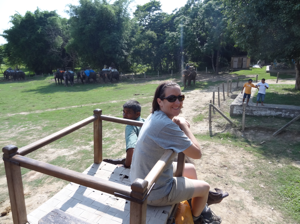 We got back from the walk just before elephant bathing time. Meg got to climb aboard an elephant and get sprayed with river water - over, and over, and over again. I got good pictures, and she got very wet, if not clean.
We got back from the walk just before elephant bathing time. Meg got to climb aboard an elephant and get sprayed with river water - over, and over, and over again. I got good pictures, and she got very wet, if not clean.
Our last adventure of the day was the elephant ride. We didn't ride them for comfort, but for the wildlife viewing possibilities. Other animals don't get scared when elephants walk by. So they load foreigners up, four to an elephant, and meander through the jungle. The "saddle" is a square platform with a 2' height railing. Each person sat at a corner with legs hanging down. I did feel secure, even when going up hills when my body seemed to be suspended 10' above the ground. But I have bruises from that railing.
 It was charming to spot animals sleeping on the undergrowth, though mostly deer. A couple monkeys scampered by. A couple male peacocks strutted by, though I didn't get good pictures through the undergrowth. But the best thing was arriving in a clearing to see four rhinos. We got great views of them (including many rhino butt pictures) and also of the view of six elephants full of tourists next to four rhinos.
It was charming to spot animals sleeping on the undergrowth, though mostly deer. A couple monkeys scampered by. A couple male peacocks strutted by, though I didn't get good pictures through the undergrowth. But the best thing was arriving in a clearing to see four rhinos. We got great views of them (including many rhino butt pictures) and also of the view of six elephants full of tourists next to four rhinos.
I forgot to mention that we didn't have to share the elephant ride with total strangers. We pulledmupmthe the elephant area and spotted our new friends Ann and Mike, from California. We hadn't seen them since Lukla. Small world. It was great to see them, and to share the elephant adventure with them.
The last adventure in Chitwan came overnight. Around 1 am, the sky opened up. I don't know how much rain fell in the next couple hours (it was far too dark to see) but I wouldn't be surprised if it was 4 or 5 inches. That whole town floods during the monsoon, and this was a pretty clear indicator that the monsoon season had indeed arrived a bit early this year.
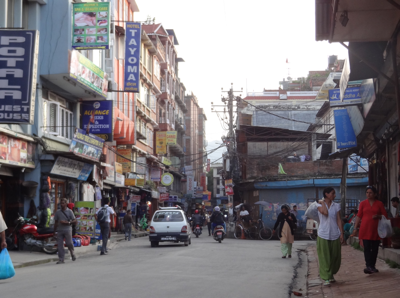
So now we are back in Kathmandu, packing, shopping, and enjoying our last few hours before starting the long journey home! We should arrive in Minnesota on Wednesday evening, local time. See you all soon.


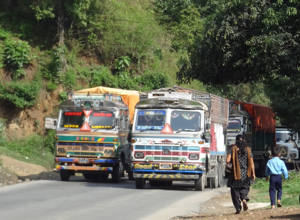

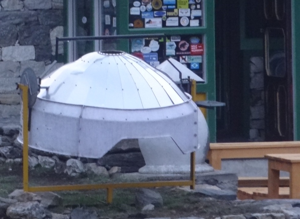 As you go up the mountain power becomes more and more expensive and less and less common. Many things you see only in the homes of ardent environmentalists at home are commonplace here- simply because they help people save money and have things they could't otherwise have. For example I don't think we've seen any bulbs that weren't compact florescent, and huge black water containers warming water on roofs are commonplace, frequently accompanied by solar hot water heaters. As we got higher, many hotels had solar water heaters out front, big shiny aluminum contraptions that boil a pot of water when the sun is out. Once the water is boiled, it goes into big thermos' wher it stays hot for hours till someone orders tea.
As you go up the mountain power becomes more and more expensive and less and less common. Many things you see only in the homes of ardent environmentalists at home are commonplace here- simply because they help people save money and have things they could't otherwise have. For example I don't think we've seen any bulbs that weren't compact florescent, and huge black water containers warming water on roofs are commonplace, frequently accompanied by solar hot water heaters. As we got higher, many hotels had solar water heaters out front, big shiny aluminum contraptions that boil a pot of water when the sun is out. Once the water is boiled, it goes into big thermos' wher it stays hot for hours till someone orders tea.  It was tempting to figure that once we left Namche, our trek was over. But that was far from true. First of all, it was still a long walk! We broke the trip into two days. Going down the Namche Hill was very slow for us. The long incline into Lukla at the end of the second day was actually much easier. Going down takes a lot of muscle. Going up just takes cardiovascular work. Regardless, we were both very happy to pull into Lukla around 10:30 on Wednesday.
It was tempting to figure that once we left Namche, our trek was over. But that was far from true. First of all, it was still a long walk! We broke the trip into two days. Going down the Namche Hill was very slow for us. The long incline into Lukla at the end of the second day was actually much easier. Going down takes a lot of muscle. Going up just takes cardiovascular work. Regardless, we were both very happy to pull into Lukla around 10:30 on Wednesday.  We planned five days at the end of our trek before our international flight, knowing the people occasionally get stuck here in Lukla. If we got out right away, we planned to visit the jungle, Chitwan National Park. Well, it looks like we will be lucky to make it out in those five days. Desperation is running pretty high around here, with discussions of helicopters, hiking two strenuous days to a 14 hour jeep ride, or hiking six days to Jiri. We optimistically reported to the airport at 6 am this morning, since we were booked on the second plane, a very good spot. They didn't even open the gate into the airport until after seven. We finally gave up at 10. This afternoon our incredibly helpful lodge owner (Sunrise Lodge) will rebook us for tomorrow, and we will try again, along with those who have been waiting days and those who have just arrived.
We planned five days at the end of our trek before our international flight, knowing the people occasionally get stuck here in Lukla. If we got out right away, we planned to visit the jungle, Chitwan National Park. Well, it looks like we will be lucky to make it out in those five days. Desperation is running pretty high around here, with discussions of helicopters, hiking two strenuous days to a 14 hour jeep ride, or hiking six days to Jiri. We optimistically reported to the airport at 6 am this morning, since we were booked on the second plane, a very good spot. They didn't even open the gate into the airport until after seven. We finally gave up at 10. This afternoon our incredibly helpful lodge owner (Sunrise Lodge) will rebook us for tomorrow, and we will try again, along with those who have been waiting days and those who have just arrived. 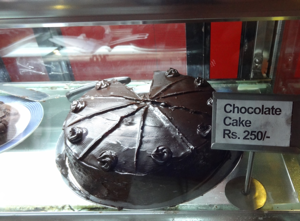 We also have amazing luxeries. Our room has an attached bathroom where I was able to take an almost-shower, with a real towel! The terry felt so good scrubbing my skin. The bakery served us a delicious pizza followed by a killer piece of chocolate cake. Our room is huge and the blankets are thick. Today we bought a whole jar of peanut butter and ate 1/3 of it for lunch. It was SO good. We took some small hikes around town, enjoying the stonework, the birds, plus the bovines, dogs, and chickens in the "road". And we continue to enjoy our many new friends, some who feel like old friends by now.
We also have amazing luxeries. Our room has an attached bathroom where I was able to take an almost-shower, with a real towel! The terry felt so good scrubbing my skin. The bakery served us a delicious pizza followed by a killer piece of chocolate cake. Our room is huge and the blankets are thick. Today we bought a whole jar of peanut butter and ate 1/3 of it for lunch. It was SO good. We took some small hikes around town, enjoying the stonework, the birds, plus the bovines, dogs, and chickens in the "road". And we continue to enjoy our many new friends, some who feel like old friends by now. 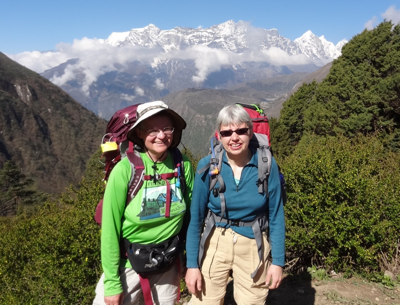 Going up takes a lot of time, tiny steps, and plenty of perserverence. It turns out that coming down is very different.
Going up takes a lot of time, tiny steps, and plenty of perserverence. It turns out that coming down is very different.  Saturday night we stayed at the Rivendell Lodge in Deboche. Yes, it was indeed named after Lord of the Rings. It was nice. There were rules, like leaving shoes outside our rooms. But there were also hot towels before dinner. It was hard to clean only our faces! And there were amusing guests. A large group came in at dinner time, and I started talking to a woman from Montana. It turns out that she is the head doctor at the Base Camp medical clinic, Lulu. She was going up with a filming crew from Sydney 60 minutes. In the morning we watched her test the heart rate and blood oxygen of a fellow trekker and a Sherpa. Perhaps we can see the result on camera one day.
Saturday night we stayed at the Rivendell Lodge in Deboche. Yes, it was indeed named after Lord of the Rings. It was nice. There were rules, like leaving shoes outside our rooms. But there were also hot towels before dinner. It was hard to clean only our faces! And there were amusing guests. A large group came in at dinner time, and I started talking to a woman from Montana. It turns out that she is the head doctor at the Base Camp medical clinic, Lulu. She was going up with a filming crew from Sydney 60 minutes. In the morning we watched her test the heart rate and blood oxygen of a fellow trekker and a Sherpa. Perhaps we can see the result on camera one day.  Sunday was easier for me. We hurried down the huge Tengboche hill, trying to stay ahead of a yak train we had carefully passed. After a cup of hot chocolate in Phunki Tenga, we started up the hill on the other side of the river. I had been dreading going back up that hill, so I was pleasantly surprised. We took it very slowly and I loved every minute of it. My muscles, heart and lungs were happy with the slow pace - no faster than before. And my senses were delighted by the rocky trail, actual trees, birds, and of course the views. Meg was not as fond of the endless climb as me.
Sunday was easier for me. We hurried down the huge Tengboche hill, trying to stay ahead of a yak train we had carefully passed. After a cup of hot chocolate in Phunki Tenga, we started up the hill on the other side of the river. I had been dreading going back up that hill, so I was pleasantly surprised. We took it very slowly and I loved every minute of it. My muscles, heart and lungs were happy with the slow pace - no faster than before. And my senses were delighted by the rocky trail, actual trees, birds, and of course the views. Meg was not as fond of the endless climb as me.  When we left on this trek, I knew I would meet people from Nepal, but I had no idea how much of the rest of the world gathered here. The trail to Everest base camp is also the main road to many villages so of course we've met many people from Nepal as they walk to and from school, home from a shopping trip down the mountain, along the trail to the next village to visit, babies and toddlers in tow or haul loads of just about everything up the mountain. At first we were surprised to be passed by porters hauling eggs, hay, toilet paper, plywood or even bottled water, but soon we realized that anything that wasn't grown up here had to come up by porter, yak or helicopter and most of it comes via porter.
When we left on this trek, I knew I would meet people from Nepal, but I had no idea how much of the rest of the world gathered here. The trail to Everest base camp is also the main road to many villages so of course we've met many people from Nepal as they walk to and from school, home from a shopping trip down the mountain, along the trail to the next village to visit, babies and toddlers in tow or haul loads of just about everything up the mountain. At first we were surprised to be passed by porters hauling eggs, hay, toilet paper, plywood or even bottled water, but soon we realized that anything that wasn't grown up here had to come up by porter, yak or helicopter and most of it comes via porter. 
 The trip started with some of the most amazing toilets I've ever seen - in the Minneapolis Saint Paul airport. They were clean, large, and beautiful, with lots of marble and an electronic display at the entrance listing wait time. Perhaps a little over the top?
The trip started with some of the most amazing toilets I've ever seen - in the Minneapolis Saint Paul airport. They were clean, large, and beautiful, with lots of marble and an electronic display at the entrance listing wait time. Perhaps a little over the top? 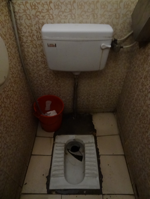 We encountered our first squat toilets at the Kathmandu airport, domestic terminal. We spent five hours there, so I was grateful for them - they did the job. A Minnesota friend of mine told me once that she prefers public squat toilets - she thinks they are more hygienic than the seat style. These were a bit dirty. There was a bucket for toilet paper (bring your own) and a pitcher to sluice the toilet when you were done.
We encountered our first squat toilets at the Kathmandu airport, domestic terminal. We spent five hours there, so I was grateful for them - they did the job. A Minnesota friend of mine told me once that she prefers public squat toilets - she thinks they are more hygienic than the seat style. These were a bit dirty. There was a bucket for toilet paper (bring your own) and a pitcher to sluice the toilet when you were done. 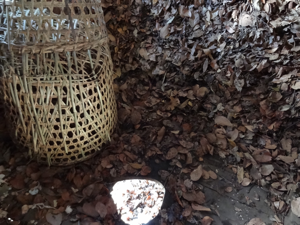 Finding toilet facilities on the trail out of Lukla was a bit of a challenge, especially at first, when we didn't always recognize them. And since we were trying to drink a lot of water, we needed them pretty quickly. But soon we saw a building marked toilet, and gratefully checked it out. It was a small building on a slope. There was a hole in the floor and a mound of leaves. That's it. Very biodegradable. I liked the simplicity.
Finding toilet facilities on the trail out of Lukla was a bit of a challenge, especially at first, when we didn't always recognize them. And since we were trying to drink a lot of water, we needed them pretty quickly. But soon we saw a building marked toilet, and gratefully checked it out. It was a small building on a slope. There was a hole in the floor and a mound of leaves. That's it. Very biodegradable. I liked the simplicity. 
 Our lodge in the tiny hilltop monestary community of Tengboche was one of my least favorite. The small bathroom at the end of the hallway had a squat toilet, a bucket for paper (of course not provided), and two bins of water. One was to "flush" the toilet. The other had a spigot and sink to wash hands. Not bad, though hard for bathing. I managed after a fashion, despite the cold wind whistling though the broken window and cracks in the walls. Oh, I guess there was some paper provided. There was an old paperback book, which was clearly being used, one page at a time.
Our lodge in the tiny hilltop monestary community of Tengboche was one of my least favorite. The small bathroom at the end of the hallway had a squat toilet, a bucket for paper (of course not provided), and two bins of water. One was to "flush" the toilet. The other had a spigot and sink to wash hands. Not bad, though hard for bathing. I managed after a fashion, despite the cold wind whistling though the broken window and cracks in the walls. Oh, I guess there was some paper provided. There was an old paperback book, which was clearly being used, one page at a time.  Every time we move higher, the terrain changes. It's stunning.
Every time we move higher, the terrain changes. It's stunning. 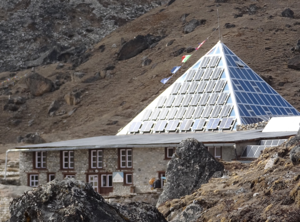 After settling in, I left Meg in the dining room and hiked up alone up the valley to see the Italian research station. They have this gorgeous pyramid, covered with solar panels. On my way back, I stopped to just sit on a rock. The edge of the glacial valley was so quiet. Clouds still obscured most of the mountains, but I got the occasional view.
After settling in, I left Meg in the dining room and hiked up alone up the valley to see the Italian research station. They have this gorgeous pyramid, covered with solar panels. On my way back, I stopped to just sit on a rock. The edge of the glacial valley was so quiet. Clouds still obscured most of the mountains, but I got the occasional view.  I loved the hike. First was more of the glacial valley, a gentle ascent. Then we climbed a hill and the way got rockier and rockier. We turned a corner, looked down, and there was an actual active valley glacier. I've seen plenty of glacial valleys, but never one still filled with ice. The top layer was dirty, but there were big holes where we could see the aqua tinge of the ice and some were filled with water like mini lakes. Other places there were hundreds of strange ice mounds. I was in awe.
I loved the hike. First was more of the glacial valley, a gentle ascent. Then we climbed a hill and the way got rockier and rockier. We turned a corner, looked down, and there was an actual active valley glacier. I've seen plenty of glacial valleys, but never one still filled with ice. The top layer was dirty, but there were big holes where we could see the aqua tinge of the ice and some were filled with water like mini lakes. Other places there were hundreds of strange ice mounds. I was in awe. 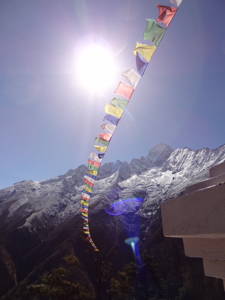 I pondered other ways I could have been spending my vacation. I could have been sitting on a beach, with a book, for much less money. Instead I was pulling my body and my 12 kg pack (about 25 pounds) step after difficult step up a mountain in the strong sun without enough oxygen. Crazy, right?
I pondered other ways I could have been spending my vacation. I could have been sitting on a beach, with a book, for much less money. Instead I was pulling my body and my 12 kg pack (about 25 pounds) step after difficult step up a mountain in the strong sun without enough oxygen. Crazy, right?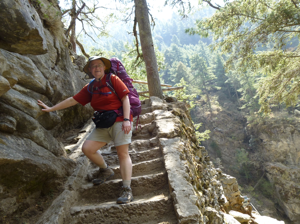 We started the day with delicious porridge and overcooked omelet, then headed up stone steps, down steps, and so on until we reached the national park checkpoint, officially entering Sagarmatha National Park. For awhile we hiked right next to the Dudh Kosi, which was almost flat. But then we spotted the final bridge of the day in the distance - and VERY high up. Sure enough, more steps appeared, and we went up, and up, and up. I had to use my hands to balance the narrow rocky ledges. I have no idea how the porters with their loads managed.
We started the day with delicious porridge and overcooked omelet, then headed up stone steps, down steps, and so on until we reached the national park checkpoint, officially entering Sagarmatha National Park. For awhile we hiked right next to the Dudh Kosi, which was almost flat. But then we spotted the final bridge of the day in the distance - and VERY high up. Sure enough, more steps appeared, and we went up, and up, and up. I had to use my hands to balance the narrow rocky ledges. I have no idea how the porters with their loads managed.  We traveled slow but steady today, which meant we saw some porters over and over again. There were a couple carrying sheets of plywood. One had five pieces of 3/8 th inch boards, about 3' x 6'. Another had a stack of "green boards", thinner boards of the same dimensions, along with a few pieces of metal roof sheeting.
We traveled slow but steady today, which meant we saw some porters over and over again. There were a couple carrying sheets of plywood. One had five pieces of 3/8 th inch boards, about 3' x 6'. Another had a stack of "green boards", thinner boards of the same dimensions, along with a few pieces of metal roof sheeting.  Saturday is the big market day in Namche Bazaar. Goods come from Lukla, but they are also carried in from Tibet. Meg likes busy farmers markets, so she went to explore, though she didn't buy anything.
Saturday is the big market day in Namche Bazaar. Goods come from Lukla, but they are also carried in from Tibet. Meg likes busy farmers markets, so she went to explore, though she didn't buy anything. 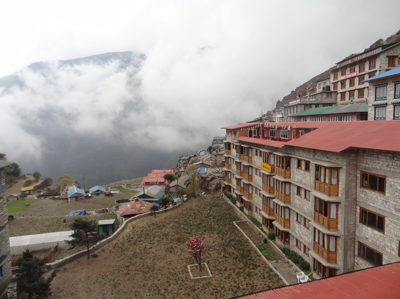
 Today is for acclimatization. We hiked straight up the hill, perhaps 400 meters of elevation gain. My headache is finally gone, but Meg wasn't feeling so hot, so we took it very slow. We know that is fine, but it is still hard to be passed by a 3 year old and old woman carrying a full load of groceries from market.
Today is for acclimatization. We hiked straight up the hill, perhaps 400 meters of elevation gain. My headache is finally gone, but Meg wasn't feeling so hot, so we took it very slow. We know that is fine, but it is still hard to be passed by a 3 year old and old woman carrying a full load of groceries from market.  I loved watching the helicopters. Many of them are evacuating ill or injured Trekkers, but today we saw one touring people around the region. This one did not crash - apparently this is an appropriate helicopter move!
I loved watching the helicopters. Many of them are evacuating ill or injured Trekkers, but today we saw one touring people around the region. This one did not crash - apparently this is an appropriate helicopter move!  Yet each time I think I've returned to a previous century I am swiftly reminded that we are firmly in the present. The young woman driving the yak towards me is texting with one hand while she harries the yak with the stick in the other hand. The younger porters listen to their I pods as they haul their heavy hand woven baskets up hill. And while some of the porters are carrying the eggs and vegetables that could be from any time past or present, others haul propane or big sheets of plywood. And in the tiny room of our very rustic hotel, the staff are watching music videos on a flat screen TV while they wait for customers.
Yet each time I think I've returned to a previous century I am swiftly reminded that we are firmly in the present. The young woman driving the yak towards me is texting with one hand while she harries the yak with the stick in the other hand. The younger porters listen to their I pods as they haul their heavy hand woven baskets up hill. And while some of the porters are carrying the eggs and vegetables that could be from any time past or present, others haul propane or big sheets of plywood. And in the tiny room of our very rustic hotel, the staff are watching music videos on a flat screen TV while they wait for customers.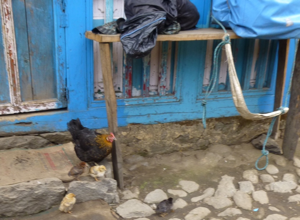 In a similar fashion, even in this new landscape I see so many reminders of home. The mother shooing the chickens from her door, just as I do many mornings. The toddlers escaping down the street, only to be caught by a caring neighbor. People stopping in the street to answer cell phones. And most of all, the young woman who paused in her gardening to serve us lunch at her families restaurant. While she waited for us to finish, a neighbor walking by with a young child stopped to chat and in the end left the toddler with our waitress. As we walked away the young woman and the toddler were crouched by the garden weeding. As the toddler waved a vigorous goodbye I thought how much like our Claire that young woman seemed . Perhaps I'm not so far from home after all.
In a similar fashion, even in this new landscape I see so many reminders of home. The mother shooing the chickens from her door, just as I do many mornings. The toddlers escaping down the street, only to be caught by a caring neighbor. People stopping in the street to answer cell phones. And most of all, the young woman who paused in her gardening to serve us lunch at her families restaurant. While she waited for us to finish, a neighbor walking by with a young child stopped to chat and in the end left the toddler with our waitress. As we walked away the young woman and the toddler were crouched by the garden weeding. As the toddler waved a vigorous goodbye I thought how much like our Claire that young woman seemed . Perhaps I'm not so far from home after all.  We whizzed through the domestic terminal, and before we knew it, we were boarding our 20 passenger Twin Otter plane for the trip 90 miles and 5,000 feet of elevation into the mountains. The plane was loud - the flight attendant passed out cotton balls for our ears. It was also terrifying and exhilarating to fly through huge cottonball clouds, wondering if the pilots would be able to land. They fly only by sight. But eventually they dived down and we magically found ourselves on the short 1,500 foot runway.
We whizzed through the domestic terminal, and before we knew it, we were boarding our 20 passenger Twin Otter plane for the trip 90 miles and 5,000 feet of elevation into the mountains. The plane was loud - the flight attendant passed out cotton balls for our ears. It was also terrifying and exhilarating to fly through huge cottonball clouds, wondering if the pilots would be able to land. They fly only by sight. But eventually they dived down and we magically found ourselves on the short 1,500 foot runway. 
 We need to gain about 9,000 feet of elevation on this trip, but the first day was mostly downhill. 300 meters of down gave my thighs quite a workout - they're still sore. But the terrain was amazing. Much of the trail is made of stone - there is a lot of it here. Fields are carefully barricaded off with waist high stone walls, allowing the animals to run free. And there are many animals. Chickens getting shooed out of houses, dogs sleeping just about anywhere, and the cows and horses who use the trail as pasture. Yak bells herald the approach of trains of donkeys or Dzongkha, yak- like beasts. We will see real yaks farther up.
We need to gain about 9,000 feet of elevation on this trip, but the first day was mostly downhill. 300 meters of down gave my thighs quite a workout - they're still sore. But the terrain was amazing. Much of the trail is made of stone - there is a lot of it here. Fields are carefully barricaded off with waist high stone walls, allowing the animals to run free. And there are many animals. Chickens getting shooed out of houses, dogs sleeping just about anywhere, and the cows and horses who use the trail as pasture. Yak bells herald the approach of trains of donkeys or Dzongkha, yak- like beasts. We will see real yaks farther up. 
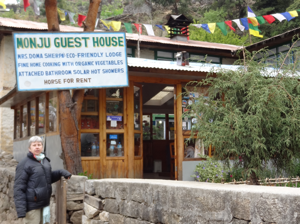 We hiked as far as we could, knowing that it would help with the long second day awaiting us. We ended up in a charming lodge in Monjo. We sprung for a room with attached bathroom, which included hot showers. Bliss. An early bedtime was in order for our aching bodies, so we snuggled in warm and tight.
We hiked as far as we could, knowing that it would help with the long second day awaiting us. We ended up in a charming lodge in Monjo. We sprung for a room with attached bathroom, which included hot showers. Bliss. An early bedtime was in order for our aching bodies, so we snuggled in warm and tight. 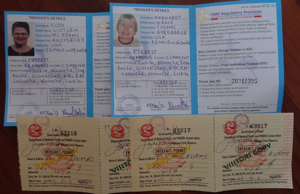 Our first day was devoted to logistical details: getting our trekking permits and plane tickets from our travel agent, changing money, and making last purchases. For about $10 we bought a supply of diamox (altitude drug), ciproflaxicin, and an inhaler for Meg. Lunch was momos and noodle soup for another $5.
Our first day was devoted to logistical details: getting our trekking permits and plane tickets from our travel agent, changing money, and making last purchases. For about $10 we bought a supply of diamox (altitude drug), ciproflaxicin, and an inhaler for Meg. Lunch was momos and noodle soup for another $5.  Today we headed to the airport early for our flight to Lukla. Now, the international terminal is tiny, but similar to other small airports I've visited. The domestic terminal is something else. Still and video photography was "strictly" forbidden, so imagine one large and very shabby room reached by a dirt path through a construction zone. We spent 5 very loud hours there, along with almost all the other domestic passengers scheduled to fly today - most flights were delayed or canceled due to weather. Even though I knew that was possible, and built days into our schedule for it, I was disappointed.
Today we headed to the airport early for our flight to Lukla. Now, the international terminal is tiny, but similar to other small airports I've visited. The domestic terminal is something else. Still and video photography was "strictly" forbidden, so imagine one large and very shabby room reached by a dirt path through a construction zone. We spent 5 very loud hours there, along with almost all the other domestic passengers scheduled to fly today - most flights were delayed or canceled due to weather. Even though I knew that was possible, and built days into our schedule for it, I was disappointed. Garbage is another issue. This morning we saw piles of garbage all over the street. We finally realized that people with shovels load it in to baskets, which they take to garbage trucks that wouldn't fit on these streets. So that's not such a bad system. But it's falling down somewhere, because the rivers look like garbage heaps and smell like open sewers. It makes me wonder. Nepali people seem very bright and extremely hard working. Why haven't they managed to clean this up?
Garbage is another issue. This morning we saw piles of garbage all over the street. We finally realized that people with shovels load it in to baskets, which they take to garbage trucks that wouldn't fit on these streets. So that's not such a bad system. But it's falling down somewhere, because the rivers look like garbage heaps and smell like open sewers. It makes me wonder. Nepali people seem very bright and extremely hard working. Why haven't they managed to clean this up? 
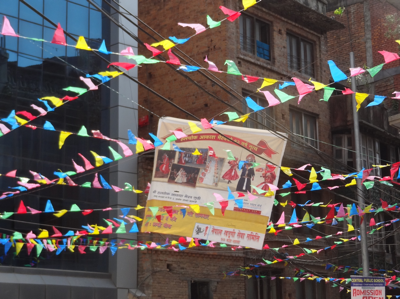 Things I'm grateful for as a traveler today:
Things I'm grateful for as a traveler today: We left around noon on Sunday. Wendy and Adam dropped us off and then headed over to the May Day parade. Security was pleasantly quick and we even got a glimpse of the parade as we flew over Minneapolis. OHare is huge - we walked as briskly as we could amyong the throngs of people, visiting almost every concourse during our three hour layover.
We left around noon on Sunday. Wendy and Adam dropped us off and then headed over to the May Day parade. Security was pleasantly quick and we even got a glimpse of the parade as we flew over Minneapolis. OHare is huge - we walked as briskly as we could amyong the throngs of people, visiting almost every concourse during our three hour layover.  Flight two was on a giant 777, from Chicago to Hethrow. We lucked out and got seats with a little extra legroom, and Meg managed to nap. I don't sleep well on planes in the best of times, and with my tail bone injury, it's almost impossible. So I watched the sunrise over the North Pole and the clouds on the ocean below, which looked like the surface of the moon. In some ways time is passing very quickly - night lasted just 6 hours.
Flight two was on a giant 777, from Chicago to Hethrow. We lucked out and got seats with a little extra legroom, and Meg managed to nap. I don't sleep well on planes in the best of times, and with my tail bone injury, it's almost impossible. So I watched the sunrise over the North Pole and the clouds on the ocean below, which looked like the surface of the moon. In some ways time is passing very quickly - night lasted just 6 hours.  We hit our first major snag in India. We stumbled blearily off the plane in India to the international transfers area at 11 pm local time, after more than 20 hours of travel. We were sent to line one, and then told to wait for "15 minutes". We were looking forward to getting horizontal, but it took a full two hours before they waved us along. Meg said she felt like the impatient American tourist, but I tried to consider it just another part of the adventure. And it had a huge silver lining. We made friends with a wonderful young woman named Saloni. She's in grad school in the Bay Area, but headed home to spend the summer with her family. The three of us found a quiet and free corner where I got a couple hours of sleep.
We hit our first major snag in India. We stumbled blearily off the plane in India to the international transfers area at 11 pm local time, after more than 20 hours of travel. We were sent to line one, and then told to wait for "15 minutes". We were looking forward to getting horizontal, but it took a full two hours before they waved us along. Meg said she felt like the impatient American tourist, but I tried to consider it just another part of the adventure. And it had a huge silver lining. We made friends with a wonderful young woman named Saloni. She's in grad school in the Bay Area, but headed home to spend the summer with her family. The three of us found a quiet and free corner where I got a couple hours of sleep.  Despite my fatigue, I feel better and better as the trip progresses. Everything is well within my plans so far. We're really going to Nepal!
Despite my fatigue, I feel better and better as the trip progresses. Everything is well within my plans so far. We're really going to Nepal!